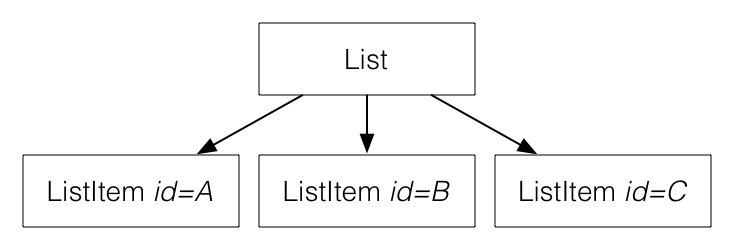Scopes
In the following component hierarchy ComponentKit has no way to distinguish the three ListItem components:

ComponentKit needs a way to uniquely identify each ListItem. Particularly as the component hierarchy is rebuilt over time:

Scopes give ComponentKit the ability to assign any component with a persistent identity: regardless of how many times a component is created it will always acquire the same scope. This behavior is required in the following three situations:
- If a component has state it must also define a scope
- If a component has a component controller it must also define a scope
- If a component has children that themselves have state or component controllers it must also define a scope when encountering a scope collision
Defining a Scope
Use CKComponentScope to define a component scope at the top of a component's +new method.
@implementation ListItemComponent+ (instancetype)newWithListItem:(ListItem *)listItem{// Defines a scope that is uniquely identified by the component's class (i.e. ListItemComponent) and the provided identifier.CKComponentScope scope(self, listItem.uniqueID);const auto c = /* ... */;return [super newWithComponent:c];}@end
If a component does not have a model object with a unique identifier a scope can be defined without one:
@implementation ListComponent+ (instancetype)newWithList:(List *)list{// Defines a scope that is uniquely identified by the component's class (i.e. ListComponent).CKComponentScope scope(self);const auto c = /* ... */;return [super newWithComponent:c];}@end
Omitting the scope's identifier is safe as long as there will not be more than one sibling component of the same type. The example above assumes ListComponent's parent will only ever render one ListComponent. If that assumption no longer holds then the parent component must specify a unique identifier for scopes of its children. This is when CKComponentKey is helpful:
@implementation ListsComponent+ (instancetype)newWithList:(NSArray<List *> *)lists{// Defines a scope that is uniquely identified by the component's class (i.e. ListComponent).CKComponentScope scope(self);const auto c = /* ... */;return[supernewWithListComponents:CK::map(lists, ^(List *list) {CKComponentKey key(@([lists indexOfObject:list]));return [ListComponent newWithList:list];})];}@end
ComponentKit's keys are an analogous to the concept of the same name in React. They allow the parent component to implicitly provide child components with a unique identifiers based on its knowledge of the component hierarchy. In the ListsComponent example each ListComponent is rendered in the order provided. Since the ListsComponent knows how it will display each ListComponent it can provide a key based on each list's order in the lists array.
Scope collisions
Scopes must be uniquely identifiable otherwise ComponentKit will be unable to reliably associate a component with its scope. When ComponentKit cannot uniquely identify two or more scopes then it has encountered a scope collision and an assertion is raised. To avoid a scope collision either:
- Define the scope of a component encountering a scope collision with a unique identifier
- Define a key in a parent component when creating children encountering a scope collision
The assertion raised by ComponentKit highlights where in the component hierarchy a scope collision is detected. Information provided by the framework includes the name of the component encountering the scope collision and where the component lives in the component hierarchy.